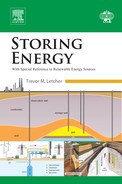Table of Contents
Chapter 1: The Role of Energy Storage in Low-Carbon Energy Systems
2. The need for new types of storage
5. Challenges for energy storage
Part B: Electrical Energy Storage Techniques Gravitational/Mechanical/Thermomechanical
Chapter 2: Pumped Hydroelectric Storage
Chapter 3: Novel Hydroelectric Storage Concepts
2. Piston-in-cylinder electrical energy storage
3. Energy membrane–underground pumped hydro storage
4. Novel land-based and seabed pumped hydro configurations
5. Offshore lagoon and island storage systems
Chapter 4: Advanced Rail Energy Storage: Green Energy Storage for Green Energy
2. Market for utility-scale energy storage
3. How much storage is needed for renewable energy?
5. Competitive storage technologies
6. Advanced Rail Energy Storage
7. ARES operational control system
9. Potential sites in the Southwestern United States
10. ARES Pilot and First Commercial Project
Chapter 5: Compressed Air Energy Storage
2. CAES: modes of operation and basic principles
4. System configurations and plant concepts
6. Integrating CAES with generation or consumption
Chapter 6: Compressed Air Energy Storage in Underground Formations
Chapter 7: Underwater Compressed Air Energy Storage
Chapter 8: A Novel Pumped Hydro Combined with Compressed Air Energy
3. Characteristics of a PHCA system
4. A Novel constant pressure PHCA energy storage system
5. The influences of work density
Chapter 9: Liquid Air Energy Storage
2. Energy and exergy densities of liquid air
3. Liquid air as both a storage medium and an efficient working fluid
4. Applications of LAES through integration
5. Technical and economic comparison of LAES with other energy storage technologies
4. The design of modern flywheels
5. Cost and comparison with other technologies
Chapter 11: Rechargeable Batteries with Special Reference to Lithium-Ion Batteries
2. Physical fundamentals of battery storage
3. Development of lithium-ion battery storage systems
Chapter 12: Vanadium Redox Flow Batteries
1. Introduction and historic development
4. VRFB versus other battery types
6. Recycling, environment, safety, and availability
Chapter 13: Phase Change Materials
2. Heat storage at subambient temperatures
3. Heat storage at ambient temperature
4. Heat storage at moderate temperatures
5. Heat storage at high temperatures
6. Heat transfer in PCM-based thermal storage systems
3. Investment and operational cost
4. Applications of solar ponds
Chapter 15: Sensible Thermal Energy Storage: Diurnal and Seasonal
1. Introduction: storing thermal energy
2. Design of the thermal storage and thermal stratification
3. Modeling of sensible heat storage
4. Second Law analysis of thermal energy storage
5. Solar thermal energy storage systems
6. Cold thermal energy storage
Chapter 16: Hydrogen From Water Electrolysis
2. Hydrogen as an energy vector and basic principles of water electrolysis
3. Hydrogen production via water electrolysis
4. Strategies for storing energy in hydrogen
5. Technology demonstrations utilizing hydrogen as an energy storage medium
6. Emerging technologies and outlook
Chapter 17: Thermochemical Energy Storage
2. Physical fundamentals of thermochemical energy storage
4. Thermochemical storage concepts
2. Dynamic electrolyzer as a core part of power- to-gas plants
3. Methanation processes within power-to-gas
4. Multifunctional applications of the power- to-gas system
5. Underground gas storage in the context of power-to-gas
Chapter 19: Traditional Bulk Energy Storage—Coal and Underground Natural Gas and Oil Storage
Chapter 20: Larger Scale Hydrogen Storage
1. Hydrogen economy—from the original idea to today’s concept
2. Why use hydrogen storage to compensate for fluctuating renewables?
3. Hydrogen in the chemical industry
4. Options for large-scale underground gas storage
5. Underground hydrogen storage in detail
Chapter 21: Energy Storage Integration
6. Integrated modeling approach
Chapter 22: Off-Grid Energy Storage
1. Introduction: the challenges of energy storage
2. Why is off-grid energy important?
3. Battery technologies and applications
4. Dealing with renewable variability
5. The emergence of minigrids and microgrids
6. Energy storage in island contexts
7. Bring clean energy to the poor
8. The way forward: cost–structure evolution
Part G: International Issues and the Politics of Introducing Renewable Energy Schemes
Chapter 23: Energy Storage Worldwide
1. Introduction: the energy storage challenge
2. Barriers to development and deployment
4. Lessons for the development of storage
Chapter 24: Storing Energy in China—An Overview
2. Imperativeness and applications
3. Technical and development status
Chapter 25: The Politics of Investing in Sustainable Energy Systems
2. Sustainable energy systems policy and politics
3. Implications for investment in sustainable energy systems
